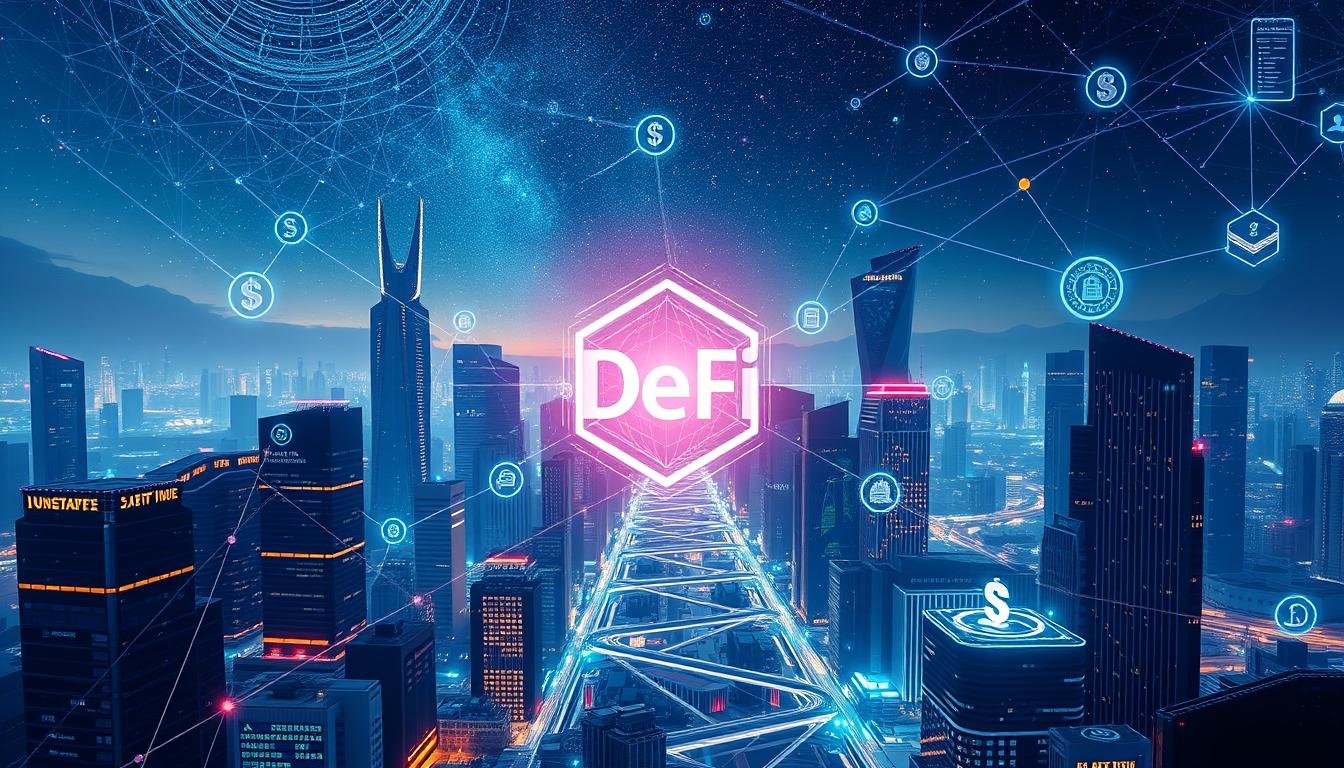Decentralized Finance (DeFi) 2.0: What’s Next?
DeFi 2.0 is a big step forward in decentralized finance. It tackles the problems of DeFi 1.0 and brings new ideas. This new version will change how we think about money and finance.
DeFi 1.0 started with ideas like decentralized exchanges and lending. But now, it’s time to fix some issues. DeFi 2.0 uses blockchain, DApps, smart contracts, and more to make things better.
Key Takeaways
- DeFi 2.0 introduces enhanced liquidity solutions to optimize capital efficiency and returns for liquidity providers.
- Layer 2 solutions are enhancing the scalability of DeFi applications, reducing transaction fees and increasing throughput.
- Interoperability solutions are enabling seamless movement of assets across different blockchains, expanding the reach of DeFi.
- DeFi 2.0 is improving liquidity pools and yield farming mechanisms for more dynamic and adaptable liquidity management.
- Cross-protocol liquidity integration is decreasing slippage and enhancing trading efficiency in the DeFi ecosystem.
Understanding the Evolution from DeFi 1.0 to DeFi 2.0
Decentralized Finance (DeFi) has changed the financial world. Its move from DeFi 1.0 to DeFi 2.0 is a big step forward. DeFi 1.0 started in 2018, bringing new ways to trade tokens, lend money, and use stablecoins. But, it faced problems like slow transactions, scalability issues, and high costs.
DeFi 1.0: The Foundational Stage
DeFi 1.0 introduced new ideas like Uniswap for trading, Aave for lending, and DAI for stablecoins. These projects showed how blockchain technology, decentralized applications (DApps), and smart contracts could change finance. But, DeFi 1.0’s limits soon became clear.
Limitations of DeFi 1.0
DeFi 1.0 had high transaction fees, was hard to scale, and had security problems. These issues made it hard for more people to use DeFi. As the field grew, the need for better solutions became clear, leading to DeFi 2.0.
DeFi 2.0 aims to fix DeFi 1.0’s problems. It focuses on better liquidity solutions, layer 2 scalability, and interoperability. DeFi 2.0 wants to make finance more accessible, affordable, and secure for everyone.
“DeFi 2.0 promises to improve user experience, costs, and speed over DeFi 1.0. It aims to make finance better by offering more protection, scalability, and ease of use.”
Key Innovations in DeFi 2.0
The new world of Decentralized Finance (DeFi) 2.0 brings exciting changes. It focuses on better liquidity, faster transactions, and easy cross-chain interoperability. These improvements aim to fix what was lacking in DeFi 1.0.
Enhanced Liquidity Solutions
In DeFi 2.0, making liquidity better is a big goal. New ideas like dynamic fees help. These fees change with the market, cutting down on losses for those who provide liquidity.
Layer 2 Solutions: Scalability
Scalability has been a big problem in DeFi. DeFi 2.0 uses Layer 2 solutions like rollups to solve this. They let more transactions happen without slowing down the main Ethereum chain, making things cheaper and faster.
Interoperability and Cross-Chain Support
DeFi 2.0 makes it easier to work with different blockchain networks. It lets assets and data move smoothly between them. This makes DeFi applications more powerful and useful.
DeFi 2.0 is making finance more efficient and connected. It’s fixing old problems and opening up new ways to use blockchain technology, smart contracts, and decentralized applications (DApps).
Decentralized Finance (DeFi) 2.0: What’s Next?
The world of decentralized finance (DeFi) is changing fast. DeFi 2.0 is the next big step in this technology. We’re seeing new ideas that are changing how we think about money.
Two big areas where DeFi 2.0 is making a big impact are better liquidity solutions and connecting different protocols together.
Improved Liquidity Solutions
The first DeFi projects had a big problem: not enough liquidity. DeFi 2.0 is fixing this with new, smart ways to manage liquidity. These new systems can change quickly to match the market, making everything more efficient.
Cross-Protocol Liquidity
Another big change in DeFi 2.0 is making it easier to move money between different platforms. Before, each platform was separate. Now, they work together better, making it easier for users to get what they need.
These changes are making DeFi stronger and more user-friendly. As it grows, we’ll see even more cool things with blockchain technology, decentralized applications (DApps), and smart contracts.
The future of DeFi is exciting, with new ideas like yield farming, liquidity mining, and cross-chain interoperability. DeFi 2.0 opens up endless possibilities for financial freedom and innovation.
“The move from DeFi 1.0 to DeFi 2.0 shows how strong and creative the decentralized finance world is. As it grows, we’re seeing a big change in how we think about money and how it can help people and communities.”
Cross-chain Interoperability: Connecting Different Blockchains
In the fast-changing world of DeFi, cross-chain interoperability is key. It lets different blockchain networks talk and work together smoothly. This makes the crypto market more united and easy to move around in.
DeFi 2.0 projects are leading the way. They’re making it possible for different blockchains to share assets and data easily. This is a big step towards a more connected crypto world.
Interoperability Solutions
DeFi 2.0 has brought big changes, like cross-chain bridges. These bridges help move assets and data between blockchains like Ethereum and Binance Smart Chain. ChainBridge and PolyNetwork are making these bridges safe and fast.
They help developers create DApps that work well on many blockchains. This opens up new chances for DeFi 2.0 apps.
Also, messaging protocols like Polkadot’s XCM and Cosmos’ IBC let smart contracts talk to each other. This makes DeFi 2.0 apps even more powerful. They can share info and do transactions across different blockchains.
Adding cross-chain interoperability is vital for DeFi’s growth. It connects blockchains, making DeFi more efficient and open. Users can now use more protocols and services, no matter the blockchain.
“Cross-chain interoperability is the future of DeFi, and it’s a huge piece of innovation that will now allow different blockchain networks to communicate and interact with one another.”
Decentralized Autonomous Organizations (DAOs)
A major part of DeFi 2.0 is the rise and adoption of decentralized autonomous organizations (DAOs). These platforms are changing the industry. They bring community control and governance to a new level. DAOs let users directly participate in DeFi project decisions, making them more democratic and transparent.
DAOs are built on a governance token. This token represents a person’s share and voting power. As the Total Value Locked (TVL) in DeFi grows, DAOs give users a say in managing and developing these protocols.
OlympusDAO is a key example in DeFi 2.0. DAO members can increase their voting power by buying more OHM tokens, the platform’s native cryptocurrency. This encourages investors to act responsibly, as their influence grows with their tokens.
But DAOs face security challenges. There’s a risk of treasury reserve theft if security is weak. Also, the speed of decision-making can slow down due to individual user votes.
Despite these challenges, decentralized autonomous organizations (DAOs) are crucial in DeFi 2.0’s evolution. They empower users and promote transparent decision-making. These platforms are reshaping decentralized finance’s future.
| Metric | Value |
|---|---|
| Total Value Locked (TVL) in DeFi | Continuously increasing |
| DeFi Lending Utilization Ratio | Low due to more assets and lenders than borrowers |
| Largest DEX | Uniswap |
| First Uncollateralized Loan in DeFi | Introduced by Aave |
| Notable DAO in DeFi 2.0 | OlympusDAO |
“DAOs distribute voting power based on the number of tokens held, incentivizing those with more tokens to act in good faith.”
In conclusion, the rise of decentralized autonomous organizations (DAOs) is a big step in DeFi 2.0. They empower users and promote transparent decision-making. These platforms are set to shape decentralized finance’s future.
Decentralized Identity Solutions
The DeFi world is growing fast, and we need better identity solutions. DeFi 2.0 brings new ways to use blockchain technology for secure and private identities.
Decentralized identity solutions let us trustlessly verify who we are. They cut down on the need for old-school, centralized systems. Thanks to blockchain technology, we can manage our digital lives without middlemen.
Secure and Confidential Identity
With blockchain technology, we get verifiable credentials for decentralized applications (DApps). This keeps our data safe and private. No single authority controls our personal info.
- Decentralized identity solutions let us share just what’s needed, cutting down on data risks.
- They use non-fungible tokens (NFTs) for digital identities. This makes verifying who we are safe and private.
- These systems give us control over our digital lives. This builds trust and transparency in DeFi.
As DeFi grows, secure identity solutions are key. They help make a fair and trustworthy financial world. Here, users can deal with confidence, knowing their data is safe.
“Decentralized identity solutions are the key to unlocking the true potential of DeFi, as they provide users with the control and privacy they deserve in the digital age.”
Conclusion
DeFi 2.0 is a big step forward in decentralized finance. It fixes the problems of DeFi 1.0 and brings new ideas. These include better liquidity, faster transactions, and working across different blockchains.
These changes will make DeFi easier to use and more open to everyone. It will help more people get financial services they need. DeFi 2.0 could also help the poor get access to money and cut down on costs.
The DeFi world is growing fast, with Ethereum, Binance Smart Chain, and Solana leading the way. But, it faces challenges like making it faster, safer, and dealing with rules. These hurdles must be overcome for DeFi 2.0 to succeed and grow.
Source Links
- DeFi 2.0: The Next Wave of Financial Innovation
- Rise of Decentralized Finance (DeFi
- Defi to Defi 2.0: The Evolution of Decentralized Finance – Webisoft Blog
- The Rise of DeFi 2.0: What You Need to Know
- Deciphering the DeFi Evolution from 1.0 to 2.0 to 3.0 – KiwiTech
- DeFi 2.0 Explained: A Beginner’s Guide To Next Gen DeFi Protocols | Mudrex Learn
- DeFi 2.0: The Future of Decentralized Finance
- DeFi 2.0: The Future of Decentralised Finance
- The Exciting Next Chapter in Decentralized Finance – Two Sigma
- Cross-Chain Interoperability: Bridging Asset Chain with Other Blockchain Networks
- What Is Cross Chain DeFi? | Chainlink
- Unlock the Benefits of Cross-Chain Interoperability with Blaize
- What is DeFi 2.0?
- Decentralized Autonomous Organization (DAO): Definition, Purpose, and Example
- The Ultimate Guide to DeFi: Revolutionizing Finance | Principles to Future
- Top 12 Use Cases of Decentralized Finance (DeFi)
- Decentralized Finance (DeFi): Reshaping the Financial Landscape
- The Rise of Decentralized Finance (DeFi) : Era of Financial Innovation






